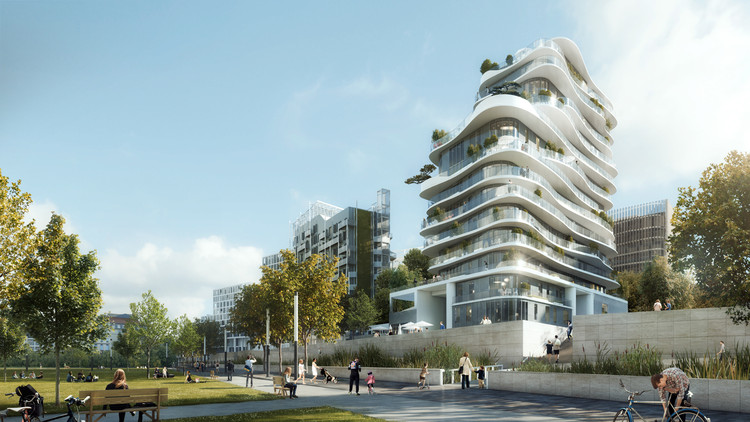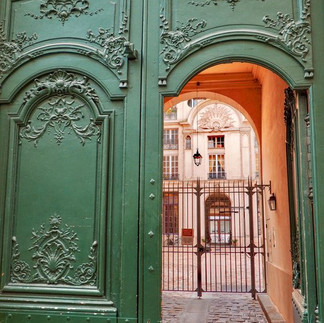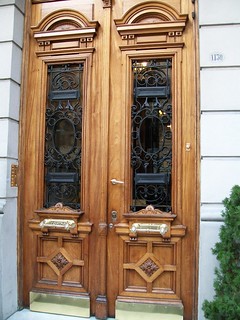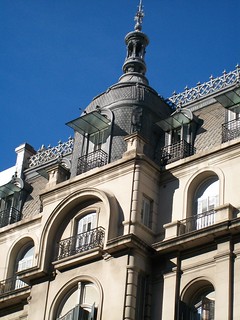Will tomorrow's cities still have a soul?
- Alexandre Richard

- Nov 1, 2021
- 5 min read
Updated: Nov 2, 2021

From left to right: Dijon (France), New Orleans (USA), Chefchaouen (Morocco), Kyoto (Japan)
I love architecture, buildings, decoration, urbanism. I try and keep up with the latest news in terms of urban project. One thing is questioning me increasingly over though: while many new buildings seem to be engineering masterpieces, I almost never see in them any design/ visual elements that tie them to the cultural anchorage of the city/ country they are built in.
Let's take a first example. A Parisian building called "UNIC". It's interesting as a building, but also in terms of location (the North of the 17th arrondissement: "Les Batignolles"). I'm saying interesting because Paris is sort of stuck/ limited by its own walls: the "périphérique", the highway surrounding Paris. The beautiful aesthetics associated to Paris have always been confined to these walls, and the city has always struggled (in my opinion) to expand its appeal to its suburbs.
With this very district (Clichy-Batignolles), the city is taking the opportunity to finally create a junction between one of the most sought-after districts of Paris (Les Batignolles: old buildings, lots of local creators, super hipstery - mostly populated by super wealthy 30-40yo with a kid), and Clichy, a suburb directly attached to it.
Here is the building in question - it's part of a much broader "eco-quartier" (self labelled "green neighborhood") composed of brand new buildings:
My point is that I don't see any cue that would make one immediately associate this building (Project called "UNIC") to its location: Paris, France.
We are far from common signifiers of Frenchness or Parisianness: Haussmannian style, carriage porches, statues, gargoyles, wrought iron or even Wallace Fountains.
This is not an epiphenomenon. Close the entirety of new buildings in France are devoted from universal signifiers of Frenchness. Which is quite an accomplishment in a country so rich historically, culturally, artistically, and of course, in architecture.
And what leads me to write this piece is that the same logic seems to apply internationally.
While it looks good, I do not for a minute get "Italy" by looking at the recent building Bosco Verticale in Milan.
For an unbiased view, I simply typed "Italy" on Pinterest to see the most immediate, obvious and "proprietary" evocations. Again, Bosco Verticale feels miles away from "timeless" signifiers of Italian beauty/aesthetics. Just like the Parisian eco-building UNIC does not have an ounce of typical Frenchness.

Let's now zoom out and look at some of the latest buildings and building projects internationally. Does any of them shout any culture/ country to you? Would you be able to immediately attach each of them to their very location?
Probably not.
Here you have, from top left to bottom right:
- W350, Tokyo
- The Factory, Manchester
- M+ Museum, Hong Kong
- Opus, Dubai
- Aquarela, Quito
- Auditorio de Tenerife
I have one macro-hypothesis as on to why buildings may have become so culturally-neutral/ bland, and universal in their style.
I think what for as long as humankind has existed, habitat was built by locals. People physically living there. Very naturally, these individuals were charged and influenced by many cultural codes (in food, music, behaviors, etc.) proper to their nation.
Another form of influence, facilitated with travels, became cultural encounters. A public figure from Austria traveling one day to Spain, and commissioning a project inspired by Spanish aesthetics once they came back home. In either case, there was a real and very tangible cultural anchorage. Buenos Aires is a good example of cultural signifiers traveling back in the days. As this article rightly underlines "Instead of Spain, it was France to which Argentina looked when re-envisioning Buenos Aires. The idea was to adopt the principles that Baron Georges-Eugène Haussmann used in Paris to create a new Argentine capital. The Parisian concepts of diagonals, grand structures, parks, and vista points found their place all over the city."
Avenida de Mayo (Buenos Aires)
Looking at new buildings in 2021, I now almost city them as being an aftermath of Internet. I'll try and explain (please do note that I am by no means an architect and don't know anyone in that field. So all of this is just a personal assumption): amongst many other things, Internet has enabled talent to travel without requiring people to physically move. We can exchange ideas seamlessly, a Japanese guy can lead a project remotely with a team from Argentina, etc etc. With Internet, we're living, exchanging, communicating and creating in a gigantic melting pot. This leads to seamlessness and freedom, but it can also lead to streamlining and universalization.
In short: I hypothesize that the new buildings we see blossoming everywhere across the globe are now the mere signature of 1 given architect or 1 design consultancy rather than the signature of a country/ culture.
To look at it from a different angle, if Baron Haussmann was currently alive, trending, had Twitter, Instagram, and a solid digital network internationally, maybe we'd be constructing hundreds of buildings looking like Parisian ones from Nairobi to Perth, without any real cultural consideration behind it.
It wouldn't be an architectural crime, but it would strongly temper with people's sense of place. The very thing I struggle with when walking in the new Parisian district "Clichy-Batignolles". It looks GREAT. It doesn't look French at all (to me) - which is mentally stimulating in my case - it makes you really pause and question what surrounds you. But, in my experience, it comes with drawbacks: after 15 minutes of admiring this new district, I felt confused. I didn't know where I was. I didn't feel in Paris for sure. I felt... nowhere. Yes, that's the word. I couldn't place myself on a map. And now that I've seen it, it's clearly not a neighborhood I'd go to during my breaks when I need to unwind and enjoy my city, Paris.
Because this architectural trend seems strong and looks like it is here to stay, I wonder what cities will look like in the future. Whether they'll still have a soul and offer people a sense of place.
OR will buildings be empty shells? Hyper effective (in their carbon emissions, in comfort, in space, in air quality, etc) empty shells. A bit like the pop up store created by Snapchat in London.

"Scan to shop". In this pop up store, the building/ room does not matter whatsoever. It is literally a blank space deprived from any cultural or aesthetic cue. The sense of place only kicks in thanks to technology, which people scan the room's QR code and can look at it via their smartphones.
Which takes me to another very recent event: Facebook's change of name and their Metaverse project.
Our friend Mark is in a building, but it doesn't matter which one. It doesn't matter where it is located or how it looks because Mark can travel to whichever reality and environment he pleases on the Metaverse.
I thus wonder if it is the future of "Place".
To end on a brighter note, I wanted to do a quick focus on some cities/ cultures that seemingly manage create contemporary architecture that feels culturally grounded/ culturally evocative.
New York: the limitless urban playground

Sarcostyle Tower by Hayri Atak (New York)

432 Park Avenue (New Yokr)
Middle-East: hide and seek

Jabal Omar Development by Foster + Partners (Saudi Arabia)
Louvre Abu Dhabi (United Arab Emirates)
China: historical flamboyance
Courtyard Kindergarten by MAD Architects (Beijing)

Sunac Guangzhou Grand Theatre (Guangzhou)
Nordics: built from/ within/ around Nature
Sharp, minimalist and logic defying
Under (Norway)
Troll Wall Restaurant and Visitor Centre
All of which prove that keeping on innovating in architecture all the while respecting/ providing a genuine sense of place, space and culture is still feasible.
---------------------
About me:

My name is Alexandre RICHARD and I work/ live in Paris.
I am a freelance French Brand Strategist and Market Researcher with more than 15 years of experience (across communication, marketing strategy and market research).
I've had the luck to work from France, but also the US and China. And my numerous briefs gave me the exceptional luck to explore more than 25 cultures.
I specialize in qualitative research, commercial semiotics, trends forecasting and modelization of the future, UX, and of course, pure strategic works applied to brands.
Feel free to reach out and don't hesitate and share my articles. That's the best surprise I can get :)











































































































Comments